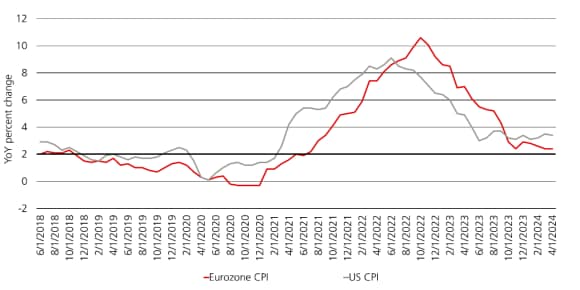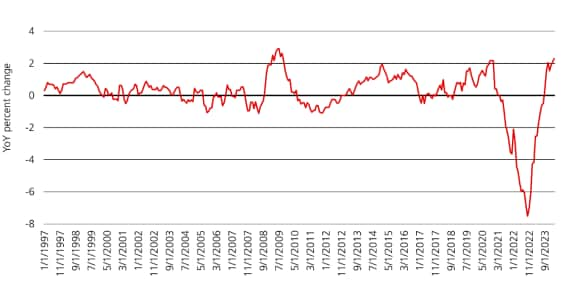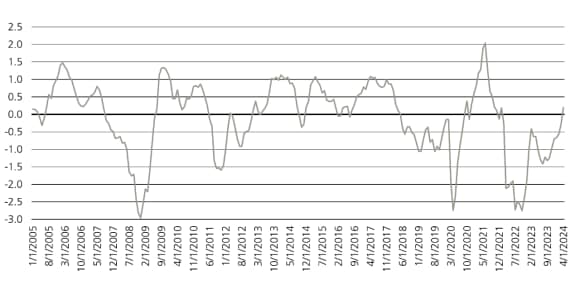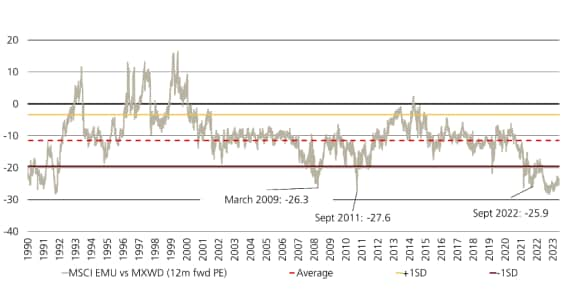Macro Monthly European summer
Investors could enjoy a European summer, with the region potentially outperforming amid a broadly constructive backdrop for risk assets.

Highlights
Highlights
- Europe will be in the spotlight this summer, with Euro 2024 set to showcase some of the world’s leading football talent. We argue that, for global investors, European markets should be equally in focus.
- The sharp decline in European inflation should allow the ECB to kick off an easing cycle next week, just as European consumption and manufacturing are rebounding. This is a uniquely positive backdrop for European risk assets, in our view.
- European stock valuations are near historical lows relative to global equities and credit spreads are comparatively attractive to the US.
- We are overweight European equities and credit this summer, as part of still broadly pro-risk positioning. We expect an ongoing healthy global nominal GDP backdrop to continue alongside a decline in bond market volatility, underpinning risk assets.
Euro 2024 kicks off in Germany on June 14 and football fans across the world will have a month to enjoy watching many of the sport’s top talent. The week before, also in Germany, the ECB is expected to kick off an easing cycle, becoming the first G4 central bank to cut rates following global monetary tightening of unprecedented speed and scale to combat inflation .
But the ECB is not easing in reaction to a sharp slowdown in growth, as is typically the case. Rather, the central bank is set to cut rates just as Europe’s economy appears to be bottoming out. Real GDP growth bounced back into positive territory in the first quarter, while leading indicators suggest global and European manufacturing is set to rebound. Meanwhile, the decline in inflation that is setting the stage for rate cuts is boosting European real incomes, which should underpin consumption.
The ECB easing into a growth acceleration is a uniquely positive backdrop for Europe’s risk assets. And this powerful combination comes at a time when European equity valuations are near record lows relative to global equities. European credit spreads, while historically narrow, still offer more cushion than their US counterparts.
Investors could enjoy a European Summer, with the region potentially outperforming amid a broadly constructive backdrop for risk assets. We remain overweight global equities and neutral fixed income as global nominal GDP remains healthy and bond volatility subsides.
A uniquely positive backdrop
A uniquely positive backdrop
Of the major developed economies, Europe has had a particularly volatile post-COVID recovery. The energy shock caused by the Russia-Ukraine war coincided with a prolonged global manufacturing hangover from a post-COVID goods consumption boom. China’s domestic demand weakness weighed on European exports, while its surge in cheap electric vehicle exports undermined Germany’s auto industry.
Exhibit 1: European headline inflation has settled near the ECB’s 2% target, while US inflation progress has stalled

While lingering headwinds remain, the outlook for Europe has become much brighter. European inflation has declined fast, allowing the European Central Bank to begin an easing cycle while the expected Federal Reserve rate cuts have been delayed by ongoing price stickiness. Europe’s disinflation along with tight labor markets has led real incomes to surge. Throughout this cycle, European consumers have been much more hesitant to spend than their American counterparts, which is probably linked to some of the shocks listed above. But rising European consumer confidence and the expected upcoming rate cuts suggest a lift in spending ahead.
Exhibit 2: Declining inflation and tight labor markets have led to a surge in real incomes
Euro area real negotiated wages (y/y)

Along with a rebound in consumption, the European business outlook is looking brighter. The Euro area PMIs, which historically correlate reasonably well with GDP growth, strengthened 0.6 points in May, driven by a 2.3 point jump in the manufacturing index. The Euro-area all industry PMI is now up a cumulative 6 points since its low in October 2023 and has been back in expansionary territory since March 2024. Other business sentiment indicators including the IFO, Sentix and ZEW surveys are rising briskly.
Exhibit 3: European economic leading indicators are surging
Average Z-score of eurozone leading indicators

All signs point to the ECB easing into a growth acceleration. And it is important to note that Europe’s economy is more sensitive to rate cuts than the US economy. European bank, non-financial corporate and mortgage debt tends to be either floating or of much shorter duration than across the Atlantic. So rate cuts should filter through more quickly into the economy, providing extra lift to Europe’s organic recovery. This should help company earnings expectations, which are starting to reflect the turn in the economy’s underlying fundamentals.
Attractive valuations
Attractive valuations
Saying European stocks are relatively cheap is almost a cliché at this point, given the scale of US outperformance for more than a decade. But the scale of the valuation discount of Europe to global equities now appears extreme. Europe’s 12-month forward P/E ratio relative to the MSCI All Country World Index is back to levels reached only in periods of severe financial stress such as the Global Financial Crisis, the Euro Area Crisis, the Russia-Ukraine war outbreak and in September 2022 when expectations for a European recession were very much the consensus view. Europe also looks relatively cheap on a sector-adjusted basis, as well as compared to bond yields. In credit, spreads in Europe are comparatively attractive to their US counterparts as well, despite better underlying fundamentals.
Exhibit 4: European stocks are historically cheap vs. global equities
European vs Global Equities 12M Forward P/E Ratio

Risks
Risks
Falling inflation is the common theme with regard to both rate cuts and a rebound in the consumer and business outlook. If the disinflation process stalls, the ECB will be forced to limit the speed and scope of its easing cycle. That said, if rate cuts are limited because of solid growth rather than sticky inflation, European markets should stay resilient.
Geopolitical tensions also have the potential to generate volatility for European assets. The Russia-Ukraine war remains active, although Europe’s impressive shoring up of natural gas storage and sourcing from alternative suppliers has significantly reduced dependence on Russian gas. Trade tensions are another concern, with Europe potentially raising tariffs on Chinese EVs and opening itself up to retaliation. There is, however, some upside risk that China’s latest announced property measures shore up consumer confidence and demand for European goods more broadly.
As the US election captures investor focus into the fall, investors will need to consider the potential for a Trump victory leading to higher tariffs on imports from all US trading partners, including Europe. We are already positioned short EUR/USD due to our expectation for monetary policy divergence, but also favor short EUR/USD to hedge against this election scenario.
Asset allocation
Asset allocation
While the US and Japan have dominated equity returns this cycle, we think it’s Europe’s turn to deliver outperformance. Still, our optimistic European outlook should be viewed in the context of broader pro-cyclical, risk-on global positioning we have held this year. The bottom line is that developed market nominal GDP is growing at a healthier pace than in the last economic cycle even as we expect a global monetary easing campaign.
As long as the global economy remains in good shape, which we expect to be the case, we believe risk assets should deliver value, even if the pace of monetary easing is slower than some would like. We expect global bonds to continue trading within a range, as the disinflation process takes time and growth remains resilient. As progress is made towards central bank targets, bond volatility should decline, supporting carry in credit and currencies.
Asset Class | Asset Class | Overall / relative signal | Overall / relative signal | UBS Asset Management's viewpoint | UBS Asset Management's viewpoint |
|---|---|---|---|---|---|
Asset Class | Global Equities | Overall / relative signal | Overweight | UBS Asset Management's viewpoint | Profits growing, breadth improving, global PMI accelerating, and inflation likely to slow over time. |
Asset Class | US | Overall / relative signal | Overweight | UBS Asset Management's viewpoint | Despite elevated valuations, room to advance as earnings grow and rates volatility calms. |
Asset Class | Europe | Overall / relative signal | Overweight | UBS Asset Management's viewpoint | Cheap valuations and leading indicators turning up. ECB expected to begin easing cycle. |
Asset Class | Japan | Overall / relative signal | Overweight | UBS Asset Management's viewpoint | Earnings outperforming, ongoing corporate reform, and still inexpensive after recent gains. |
Asset Class | Emerging Markets | Overall / relative signal | Neutral | UBS Asset Management's viewpoint | EM outperformance requires USD weakness, more evidence of China strength. Asia ex-China supported by tech goods rebound. |
Asset Class |
Global Government Bonds | Overall / relative signal |
Neutral | UBS Asset Management's viewpoint |
Ongoing resilience in global nominal GDP means rates stay higher for longer. Bonds = recession hedge. |
Asset Class | US Treasuries | Overall / relative signal | Neutral | UBS Asset Management's viewpoint | Growth and inflation expected to slow, but only gradually. Fed may not cut rates in 2024. |
Asset Class | Bunds | Overall / relative signal | Neutral | UBS Asset Management's viewpoint | Inflation is cooling, but labor market is tight and wage growth remains elevated. |
Asset Class | Gilts | Overall / relative signal | Neutral | UBS Asset Management's viewpoint | Inflation to follow global trend lower; growth not as bad as BOE has feared. |
Asset Class | Global Credit | Overall / relative signal | Neutral | UBS Asset Management's viewpoint | Attractive all-in yields amid solid growth and disinflation. But spreads are very narrow vs. history. |
Asset Class | Investment Grade Credit | Overall / relative signal | Neutral | UBS Asset Management's viewpoint | Carry-driven trade returns. Investor demand to lock-in attractive yields before rate cuts. |
Asset Class | High Yield Credit | Overall / relative signal | Neutral | UBS Asset Management's viewpoint | Spreads are tight for the right reasons as defaults stay low. But negative convexity in adverse scenarios. |
Asset Class | EMD Hard Currency | Overall / relative signal | Neutral | UBS Asset Management's viewpoint | Good restructuring news has been largely priced in; all-in yields are still attractive. |
Asset Class | FX | Overall / relative signal | - | UBS Asset Management's viewpoint | - |
Asset Class | USD | Overall / relative signal | Overweight | UBS Asset Management's viewpoint | Bullish against G10; other central banks are likely to start the cutting cycle ahead of the Fed as US inflation remains sticky. |
Asset Class | EUR | Overall / relative signal | Underweight | UBS Asset Management's viewpoint | Core inflation slowing more convincingly than in the US. Expect rate differentials to stay in US’ favor. |
Asset Class | JPY | Overall / relative signal | Neutral | UBS Asset Management's viewpoint | BOJ’s move towards tightening is slow, methodical. Better currencies to be long. |
Asset Class | EM FX | Overall / relative signal | Neutral | UBS Asset Management's viewpoint | Bullish high carry LATAM, cautious AXJ on China, geopolitical risks. |
Asset Class | Commodities | Overall / relative signal | Neutral | UBS Asset Management's viewpoint | Brent crude oil in the middle of a USD 75 to USD 90 range. Supply constraints and speculative buying driving copper. |
Make an inquiry
Fill in an inquiry form and leave your details – we’ll be back in touch.
Introducing our leadership team
Meet the members of the team responsible for UBS Asset Management’s strategic direction.


